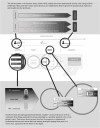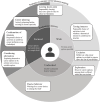Dynamics of Students' Career Choice: a Conceptual Framework-Based Qualitative Analysis Focusing on Primary Care
- PMID: 38102409
- PMCID: PMC11254893
- DOI: 10.1007/s11606-023-08567-9
Dynamics of Students' Career Choice: a Conceptual Framework-Based Qualitative Analysis Focusing on Primary Care
Abstract
Background: Increasing primary care's attractiveness as a career choice is an important task of socially accountable medical schools. Research has broadly studied influences on medical students' career choice. However, a deeper understanding of the processes behind career decision-making could support medical schools in their efforts to promote primary care careers.
Objective: To explore the dynamics of career choice during medical school with a focus on primary care, based on a previously developed conceptual framework.
Approach: Qualitative study using a phenomenological, inductive-deductive approach DESIGN AND PARTICIPANTS: Individual interviews were conducted from May 2019 to January 2020 with 14 first-year postgraduate trainee physicians, graduates of the Faculty of Medicine in Geneva, Switzerland, purposively sampled based on their interest in primary care during undergraduate studies. The interview guide was developed to elicit narratives about career-related decision-making. Two authors coded the transcripts. Thematic analysis alternated with data collection until thematic saturation was reached. Emerging themes were discussed and refined within the research team.
Key results: Two main themes emerged: (1) developing professional identity, expressed as a changing professional image from unprecise and idealistic to concrete and realistic; priorities changed from content-based to lifestyle-based preferences; (2) individual trajectories of career-related decision-making, determined by different stages of refining professional interests; students navigated this process by employing various strategies, ranging from active exploration to passive behaviors.
Conclusions: This study's narrative approach illustrates the dynamic nature of career choice and refines elements of a conceptual framework previously developed by the authors. Its findings underline the importance of exploration, for which personal experiences and observations of physicians' work are crucial. To advance efforts to make primary care a more attractive career, students must be sufficiently exposed to primary care in a safe and individualized environment and should be supported in all stages of their career choice process.
Keywords: career choice; primary care physicians; qualitative research; undergraduate medical education; workforce.
© 2023. The Author(s).
Conflict of interest statement
The authors declare that they do not have a conflict of interest.
Figures


Similar articles
-
An Expanded Conceptual Framework of Medical Students' Primary Care Career Choice.Acad Med. 2017 Nov;92(11):1536-1542. doi: 10.1097/ACM.0000000000001676. Acad Med. 2017. PMID: 28379931
-
How Do Clinical Electives during the Clerkship Year Influence Career Exploration? A Qualitative Study.Teach Learn Med. 2022 Apr-May;34(2):187-197. doi: 10.1080/10401334.2021.1891545. Epub 2021 Apr 1. Teach Learn Med. 2022. PMID: 33792448
-
Medical students' experience of the hidden curriculum around primary care careers: a qualitative exploration of reflective diaries.BMJ Open. 2021 Jul 29;11(7):e049825. doi: 10.1136/bmjopen-2021-049825. BMJ Open. 2021. PMID: 34326054 Free PMC article.
-
A thematic network for factors affecting the choice of specialty education by medical students: a scoping study in low-and middle-income countries.BMC Med Educ. 2021 Feb 10;21(1):99. doi: 10.1186/s12909-021-02539-5. BMC Med Educ. 2021. PMID: 33568113 Free PMC article.
-
Uncertainty in Decision Making in Medicine: A Scoping Review and Thematic Analysis of Conceptual Models.Acad Med. 2020 Jan;95(1):157-165. doi: 10.1097/ACM.0000000000002902. Acad Med. 2020. PMID: 31348062 Free PMC article.
Cited by
-
Exploring Motivating Factors for Pursuing Radiation Oncology: A Comparative Analysis of Medical Students and Residents.Cureus. 2024 Aug 21;16(8):e67399. doi: 10.7759/cureus.67399. eCollection 2024 Aug. Cureus. 2024. PMID: 39310570 Free PMC article.
-
'I felt I belonged': A qualitative study of role modelling and team integration as key drivers of primary care career choice.Eur J Gen Pract. 2025 Dec;31(1):2527143. doi: 10.1080/13814788.2025.2527143. Epub 2025 Jul 11. Eur J Gen Pract. 2025. PMID: 40643433 Free PMC article.
-
JGIM and the International Nature of General Internal Medicine.J Gen Intern Med. 2024 May;39(6):889-890. doi: 10.1007/s11606-024-08715-9. J Gen Intern Med. 2024. PMID: 38467920 Free PMC article. No abstract available.
-
Shining the Beam on the Next Generation: A Program Evaluation of a National Workshop Focusing on Medical Student Engagement in Radiation Oncology.J Cancer Educ. 2025 May 23. doi: 10.1007/s13187-025-02650-x. Online ahead of print. J Cancer Educ. 2025. PMID: 40408068
-
Developing the intention to pursue a general practice career: a longitudinal survey study from medical school graduation into postgraduate medical training.BMC Med Educ. 2025 Mar 21;25(1):421. doi: 10.1186/s12909-025-07006-z. BMC Med Educ. 2025. PMID: 40119404 Free PMC article.
References
MeSH terms
LinkOut - more resources
Full Text Sources

